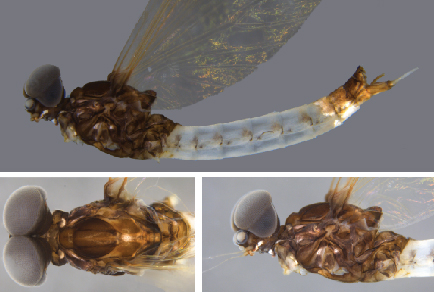Abstract
Askola fortuita sp. nov. is described based on male imagos from Southeastern Brazil, near Caparaó National Park. The new species is somewhat similar to A. froehlichi Peters, 1969 in regards to development of the male compound eyes and relative length of penis, but can be readily distinguished from this and other species of the genus by the following characteristics: dorsal portion of compound eyes widely meeting on meson of head; forewings hyaline; femora white, with a submedial mark and an apical band, both orangish brown; abdominal coloration mostly translucent white; genitalia with styliger plate washed with brown and red laterally, forceps segment I reddish-brown on basal ¼ , remainder translucent white, penes yellowish brown; penes not extending beyond posterior margin of styliger plate.
References
- Campos, R., Mariano, R. & Calor, A.R. (2019) Askola Peters 1969 (Ephemeroptera: Leptophlebiidae: Atalophlebiinae): an updated review under cladistics approach. Zoologischer Anzeiger, 283, 69–92. https://doi.org/10.1016/j.jcz.2019.08.006
- Coleman, C.O. (2003) “Digital inking”: How to make perfect line drawings on computers. Organisms Diversity & Evolution, 4, 303–304. https://doi.org/10.1078/1439-6092-00081
- Coleman, C.O. (2006) Substituting time-consuming pencil drawings in arthropod taxonomy using stacks of digital photographs. Zootaxa, 1360 (1), 61–68. https://doi.org/10.11646/zootaxa.1360.1.4
- Domínguez, E., Molineri, C. & Mariano, R. (2009) Revision of the South American species of Hagenulopsis Ulmer and Askola Peters (Ephemeroptera: Leptophlebiidae) with description of six new species. Zootaxa, 2142 (1), 29–44. https://doi.org/10.11646/zootaxa.2142.1.3
- Nascimento, J.M.C., Barcelos-Silva, P. & Salles, F.F. (2011) Two-winged Leptophlebiidae (Ephemeroptera) from Brazil: new species, records and stage description. Aquatic Insects, 33, 191–201. https://doi.org/10.1080/01650424.2011.597408
- Peters, W.L. (1969) Askola froehlichi a new genus and species from southern Brazil (Leptophlebiidae: Ephemeroptera). Florida Entomologist, 52, 253–258. https://doi.org/10.2307/3493877
- Salles, F.F. & Boldrini, R. (2022) Leptophlebiidae In: Catálogo Taxonômico da Fauna do Brasil. PNUD. Available from: http://fauna.jbrj.gov.br/fauna/faunadobrasil/19477 (accessed 16 June 2022)


